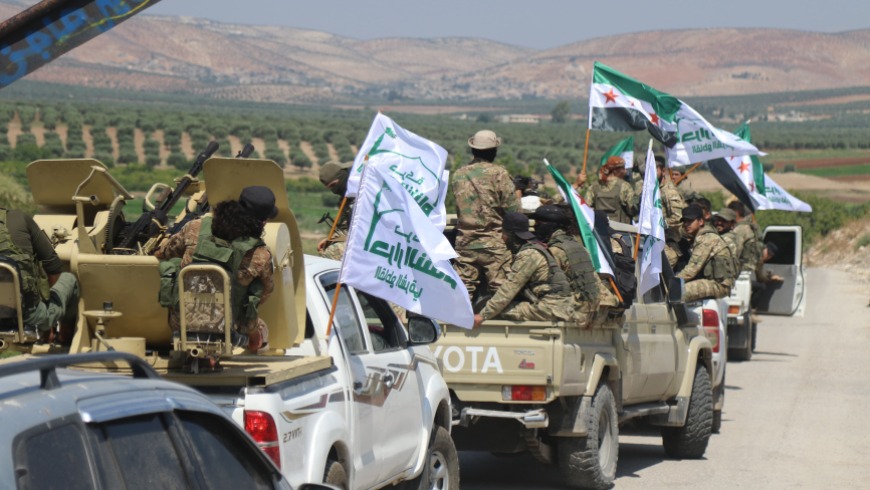The eastern countryside of Aleppo is currently a powder keg as various factions, some aligned with the Syrian National Army and others with the “Hay’at Tahrir al-Sham,” engage in mutual military build-ups. These developments are setting the stage for a potential military clash, driven by Hay’at Tahrir al-Sham’s efforts to expand its influence in the region following a recent schism within the “Ahrar al-Sham – Eastern Sector.” The dispute also involves economic interests related to control over the Al-Hamran crossing in eastern Aleppo.
The conflict within Ahrar al-Sham – Eastern Sector revolves around two factions. One is led by Muhammad Rami (Abu Haidar Maskana), who has chosen to align with the Second Corps of the National Army, severing ties with Tahrir al-Hayat. The other faction, headed by Hussein al-Talib (Abu al-Dahdah Manbij), directly coordinates with Tahrir al-Sham, further distancing itself from the National Army. The leadership of Ahrar al-Sham in Idlib, represented by Amer al-Sheikh, has also distanced itself from the National Army.
More than 400 HTS Cadres Arrested: Does al-Julani Fear a Coup?
The conflict’s roots trace back to a split within Ahrar al-Sham – Eastern Sector in April 2022, when it separated from the Third Corps of the National Army to align with Ahrar al-Sham Movement under direct coordination with Hay’at Tahrir al-Sham leader Abu Muhammad al-Julani. This move effectively made the sector an arm of Hay’at Tahrir al-Sham in National Army-controlled areas, allowing it to exert influence and control over the financially lucrative Al-Hamran crossing.
However, the recent division within the sector has escalated tensions. Abu Haidar’s decision to join the Second Corps angered the leadership of Ahrar al-Sham in Idlib and Hay’at Tahrir al-Sham. In response, they isolated Abu Haidar and appointed Abu al-Dahdah as the new sector commander. Abu Haidar had previously dismissed Abu al-Dahdah and Zakaria Al-Sharida (Abu Omar) from their positions, citing their alleged overreach of authority, further weakening the sector’s cohesion.
This dispute, initially perceived as an internal matter within Ahrar al-Sham – Eastern Sector, is emblematic of a larger conflict between two dominant forces in northern Syria: Hay’at Tahrir al-Sham and the Second Corps, particularly the “Sultan Murad Division” that assimilated the sector under Abu Haidar’s leadership.
Economic interests
Hay’at Tahrir al-Sham’s economic interests in the region were adversely affected when Al-Hamran crossing remained under Abu Haidar’s control, leading them to mobilize forces in collaboration with Abu al-Dahdah’s Ahrar al-Sham faction. Their aim is to wrest control of Al-Hamran crossing and other military sectors in proximity to areas held by the Syrian Democratic Forces (SDF).
Conversely, forces aligned with Abu Haidar have also mobilized, prepared for a potential confrontation, with directives issued by the Ministry of Defense to the National Army Corps to respond to any attack initiated by Hay’at Tahrir al-Sham.
Rival factions vie for control
One leader within Abu Haidar’s bloc described the root causes of the dispute, stating that a movement within the sector, represented by figures like Abu al-Dahdah, Zakaria al-Sharida, and Abu al-Farouq al-Bab, aimed to align completely with Hay’at Tahrir al-Sham, with support from Ahrar al-Sham’s deputy leader, Ahmed al-Dalati. On the other hand, Abu Haidar’s faction remained committed to the National Army’s overarching direction.
Efforts to isolate Abu Haidar escalated, with Amer al-Sheikh, leader of Ahrar al-Sham in Idlib, attempting direct control over the sector to ensure it followed the Hay’at Tahrir al-Sham’s agenda. Following Abu Haidar’s rejection, a statement purportedly from the Gaza Strip Shura Council was released, dismissing Abu Haidar and appointing Abu al-Dahdah as his replacement.
The situation remains precarious, with strategic points such as the Al-Hamran crossing and the Abla sector still under the control of the Abu Haidar bloc. Hay’at Tahrir al-Sham has introduced additional forces into the region under tribal cover from Idlib, exploiting recent tensions on the Manbij axis to potentially launch an attack and seize these crucial areas.
The sector’s spokesman denied any prior intention to formally align with Hay’at Tahrir al-Sham, emphasizing the high level of coordination between the two parties, particularly during confrontations against the Third Corps. Nevertheless, the situation remains fluid, with potential implications for the broader dynamics in northern Syria. Further developments are expected in the coming days as tensions escalate.
This article was translated and edited by The Syrian Observer. The Syrian Observer has not verified the content of this story. Responsibility for the information and views set out in this article lies entirely with the author.


